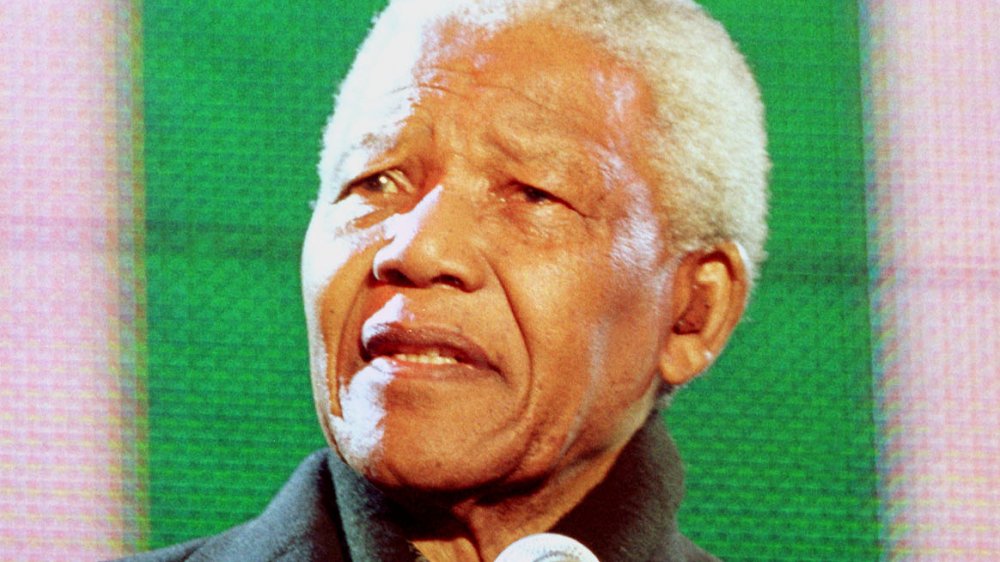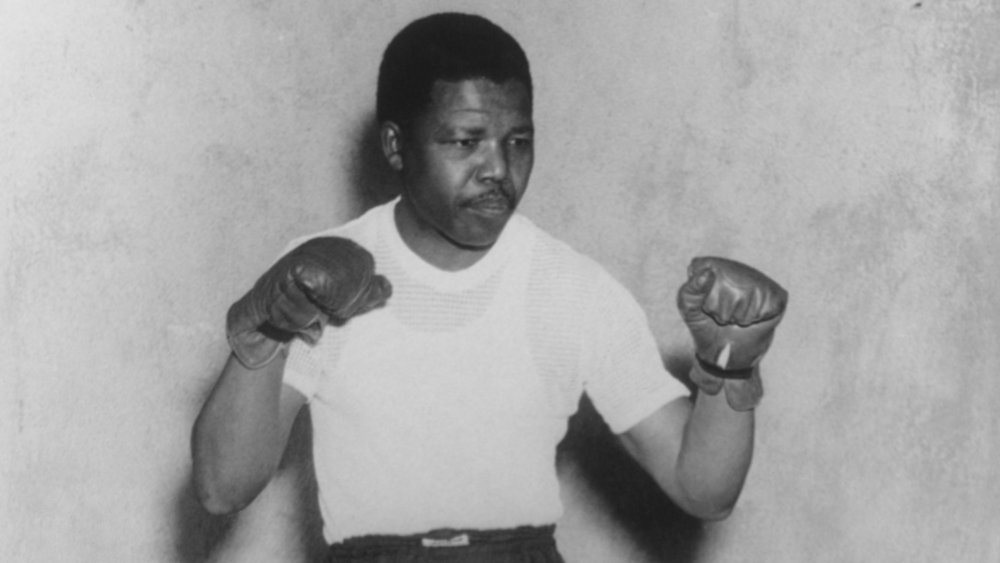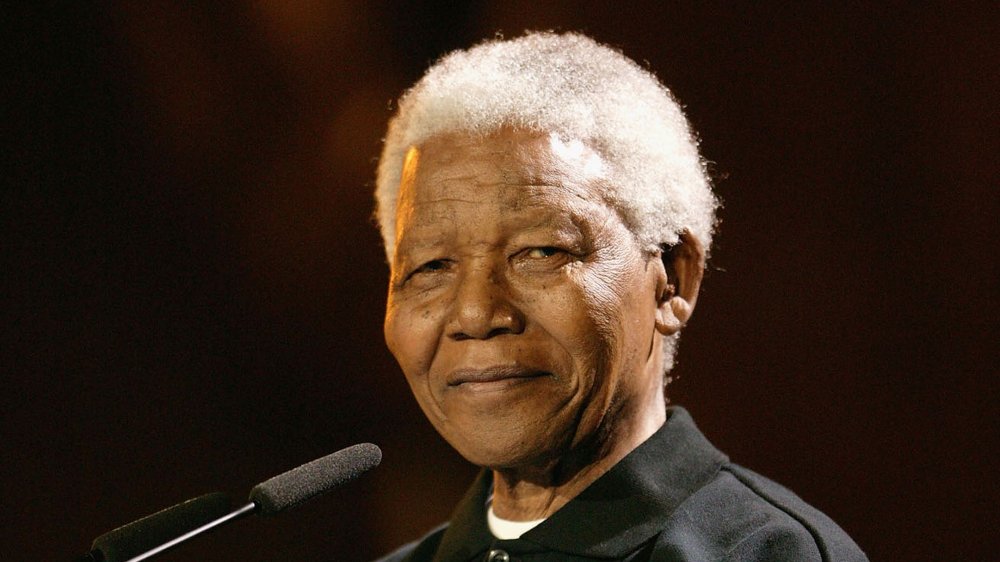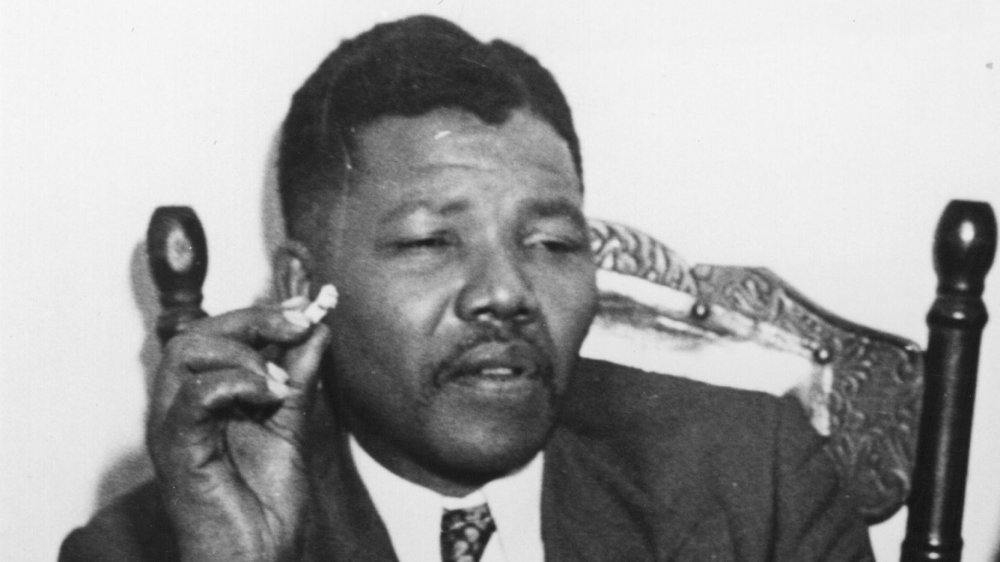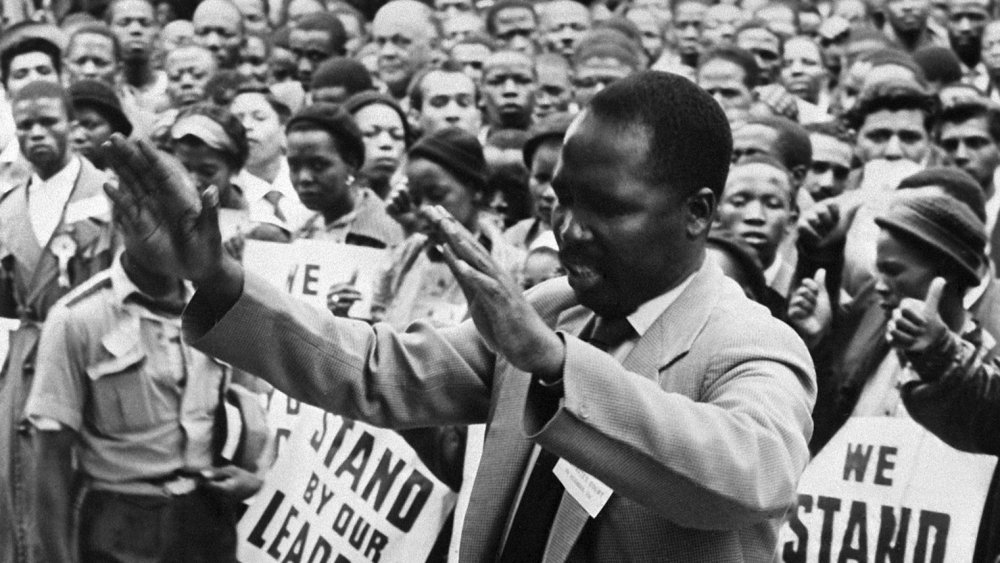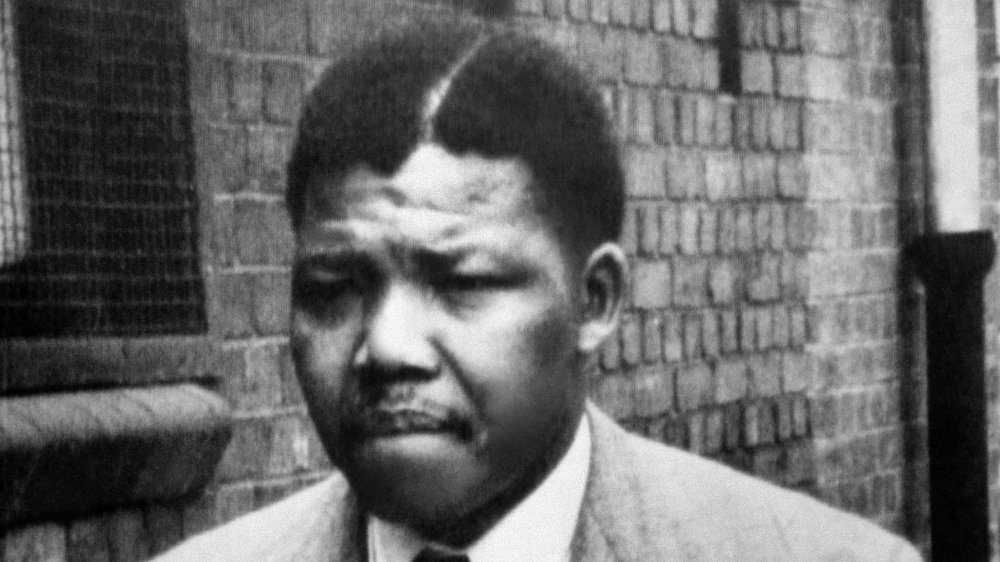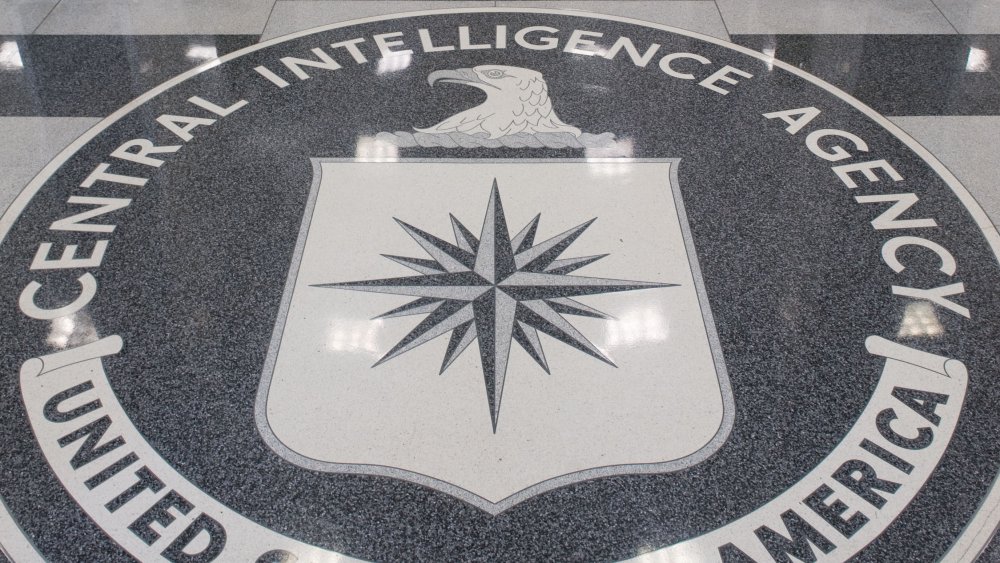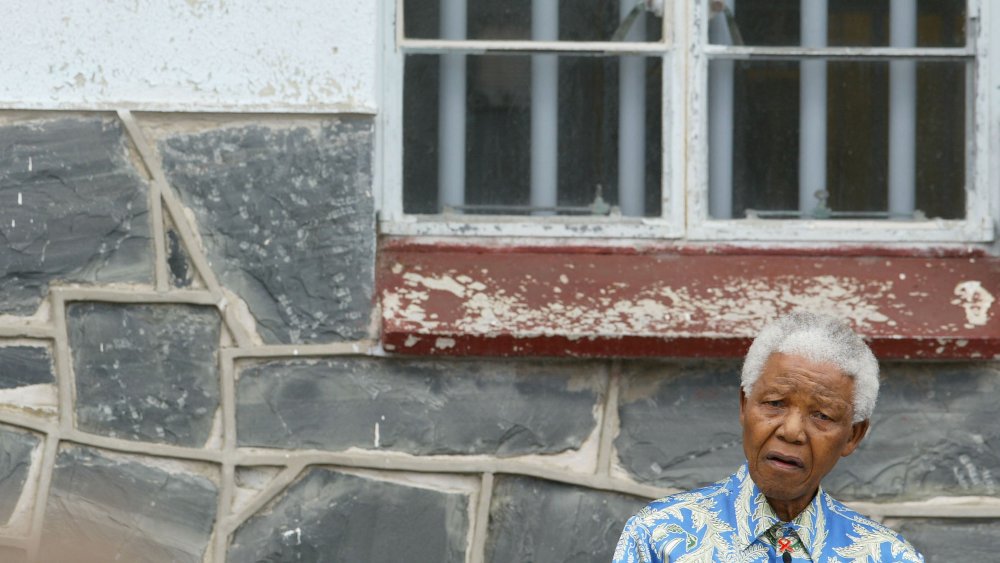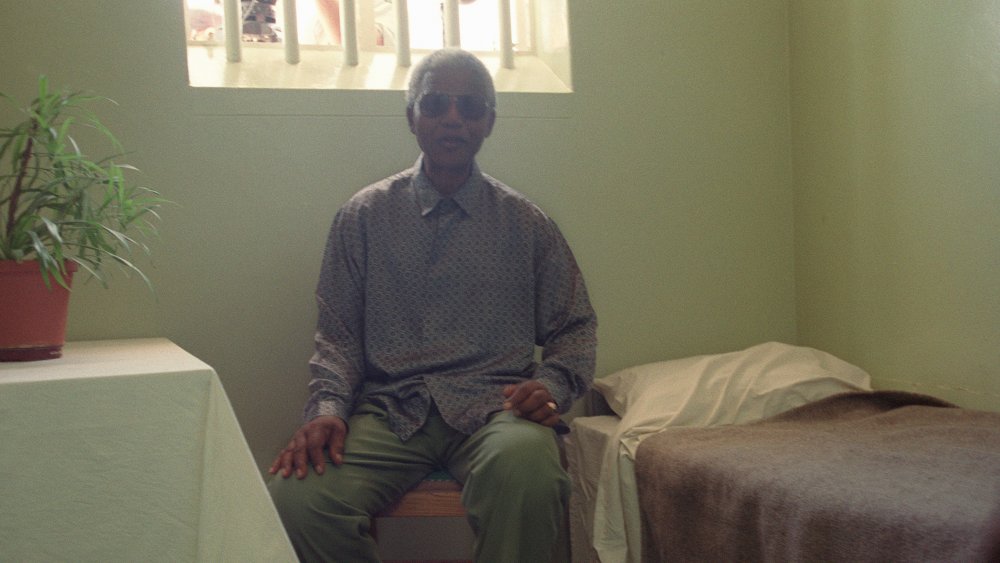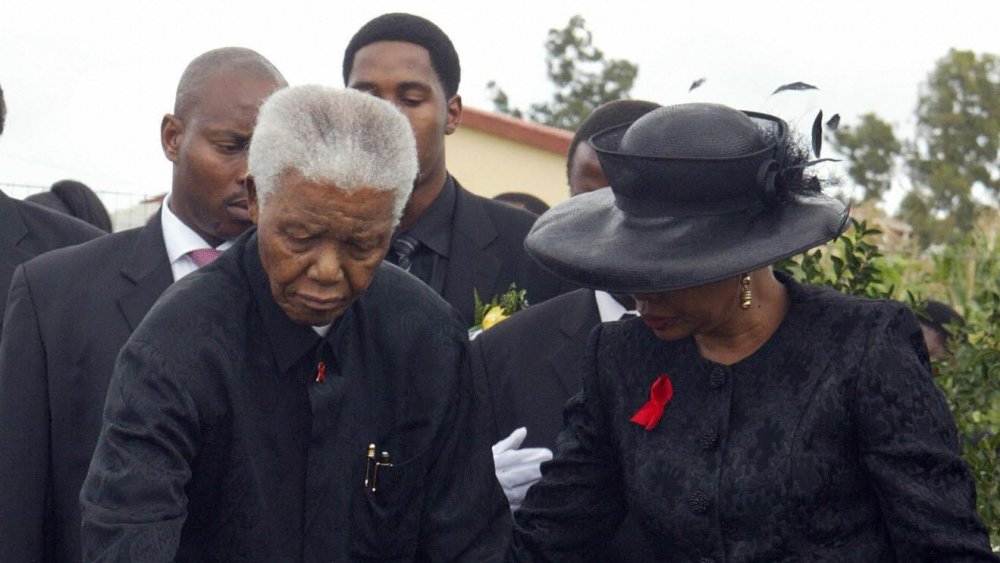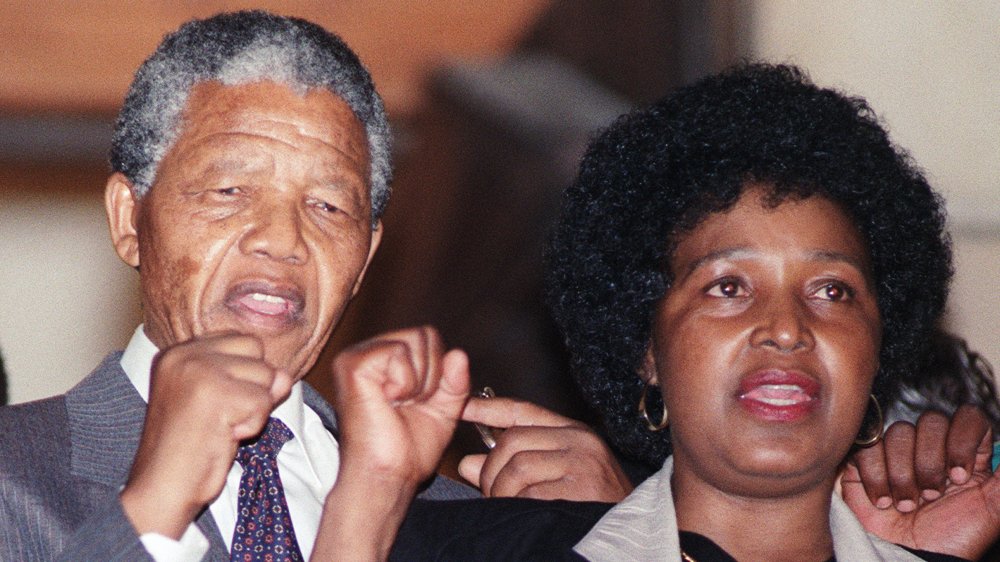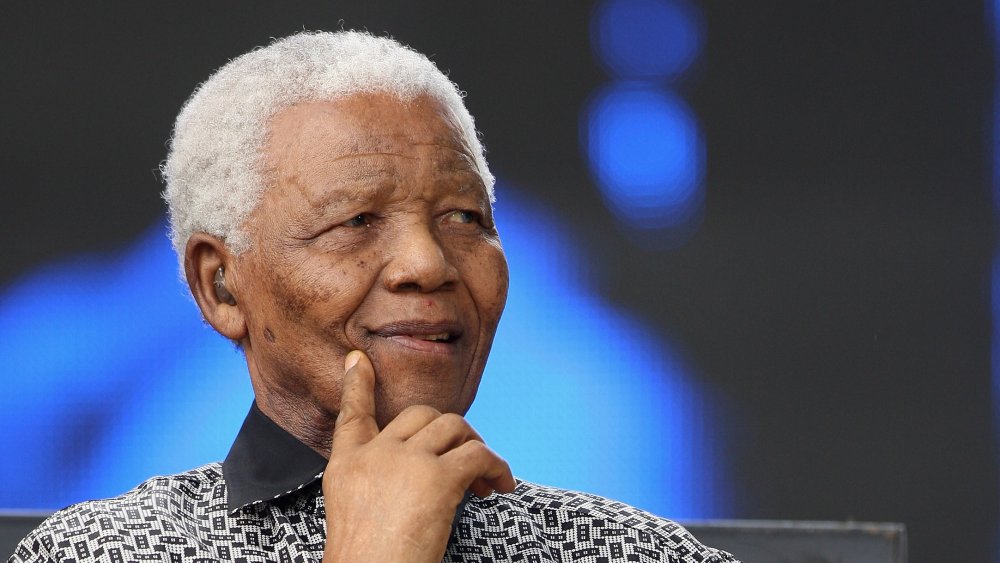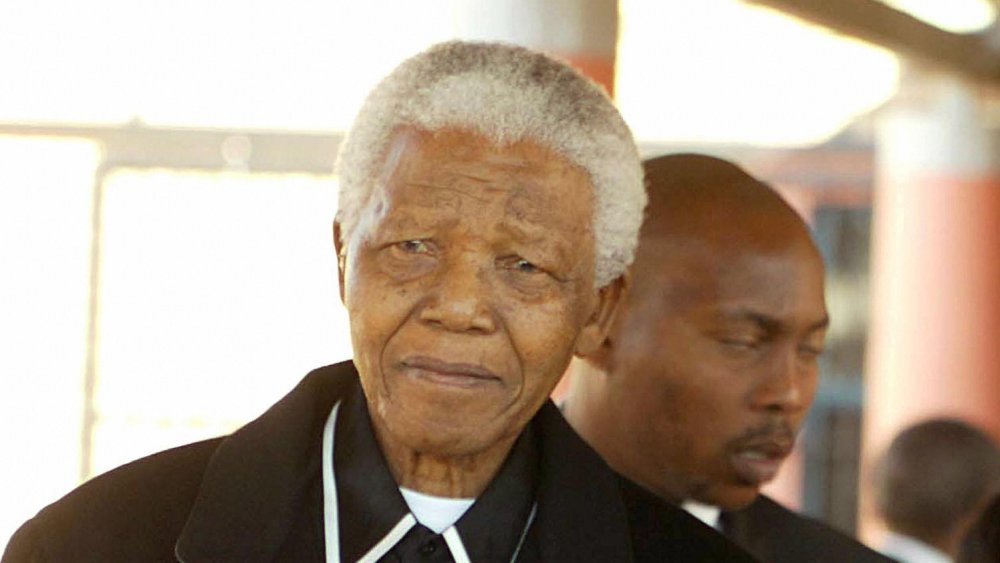The Tragic Real-Life Story Of Nelson Mandela
Nelson Mandela's name is synonymous with the fight against institutionalized racism. The South African icon's middle name was Rolihlahla, which is the Xhosa language's slang word for troublemaker. He spent his life living up to the name in the best possible way, acting as both the most famous leader and most revered figurehead of South Africa's anti-apartheid movement. He famously spent 27 years behind bars for his beliefs, and emerged from this concrete cocoon as a Nobel Peace Prize-winning national and global icon of positive change.
However, one generally doesn't become a legend without suffering significant personal loss, and Mandela's life was no exception. The smiling, compassionate statesman the world came to know was very different once you scratched the surface. Apart from the whole "spent a third of his life in prison" thing, his life was a string of misfortune that would make even the most unfortunate among us wince in anguish. Here are some of the worst events in the tragic real-life story of Nelson Mandela.
Nelson Mandela's family fell from grace when he was still an infant
Nelson Mandela's lifetime of toil and trouble started when he was still a toddler. According to Biography, he was born in a fairly prestigious Xhosa family in the tiny South African village of Mvezo. His father was a counselor for various tribal chiefs until he got on the bad side of a magistrate. The dispute cost Mandela's father his title and wealth, and the sudden hit on the family's finances and social status prompted Mandela's mother to move the family up north, to an even smaller place called Qunu.
Mandela's childhood in secluded Qunu was a poor one in ways that a citizen of a more developed nation would find difficult to comprehend. He lived in a hut and drank water from streams and his food was cooked outdoors. Even so, young "Troublemaker" found ways to entertain himself, molding toys from clay and branches, and playing games. This sort of active life likely prompted the young Mandela to develop his lifelong interest in sports, and BBC notes that he particularly enjoyed long-distance running and boxing.
Nelson Mandela's father died when he was young
Nelson Mandela's childhood troubles didn't end with his family's sudden impoverishment. As Biography tells us, the future leader was only 9-years-old when his father, who was suffering from a lung disease, died. This prompted another radical change in young Mandela's life, when his father's friend, Chief Jongintaba Dalindyebo, took the boy in. The powerful chief did this because he felt indebted to Mandela's father, who had originally recommended him for his prestigious role.
Dalindyebo's powerful position among the Thembu people meant that Mandela, whose childhood up to that point had been rural, poor, and comparatively carefree, was suddenly thrust into a fish out of water scenario where he had to face life as an adopted child of a regional ruler in a completely new, far more sophisticated place. Dalindyebo entrusted him with the same standing and duties as he did his other children, and as difficult as this must have been, Mandela answered the call. Soon, he started working his way towards an education. He became fascinated with African history and the white man's oppressive role in it, which eventually led to his political awakening at the age of 16.
Nelson Mandela's tumultuous times at school and home
As Nelson Mandela was growing up, Biography tells us that his guardian, Chief Jongintaba, wanted to entrust him with a counselor position. Higher education was required for such a high office, so in 1939, Mandela started his studies at the University of Fort Hare (Africa's equivalent of an Ivy League school). It... didn't go well.
During his first year, Mandela focused on his required classes with a heavy side of Roman-Dutch law studies (the type of legal system in the country). However, things took an unexpected turn during his second year, when he was elected to Fort Hare's Student Representative Council. This coincided with the student body's deep dissatisfaction with the university's catering and the SRC's "lack of power," which prompted Mandela to take his first steps as an activist and resign from his position to side with the people.
The university retaliated by expelling him for the rest of the year, telling he could return if he retook his spot on the council. The angry Chief Jongintaba sided with the school, and took things a step further by arranging a marriage for Mandela to make sure young Nelson's life would proceed as planned. Evidently, this was a step too far for the young man who had just taken his first steps as a person of conviction: Mandela promptly ran away from home to start a new stage of his life in Johannesburg.
Nelson Mandela and the treason trial of 1956
As the Los Angeles Times reports, the authorities were out to get Nelson Mandela for a long time before they actually got him behind bars. In 1956, no less than 156 other leading figures of the African National Congress (Mandela's political movement that sought to end apartheid through non-violent means) were imprisoned and charged with treason, and Mandela was among the accused. The high-profile trial lasted until 1961, but ultimately, everyone involved was acquitted. Ironically, Mandela in particular was not exactly a man of peace at that point. He had already started embracing more radical thoughts around 1953, when he gave his "No Easy Walk to Freedom" speech that called for the ANC to rethink its moderate approach against the oppressors. He did tell the court that he was all about non-violence, but in reality, Mandela actually only perceived the whole "don't break stuff" thing as a tactical choice. In fact, after he was released in 1961, he went on to establish the militant Umkhonto we Sizwe.
To be fair, in his later years, Mandela never shied away from the fact that he was no saint, and many think that his willingness to embrace the more violent side of things was actually instrumental in ending apartheid as early as it did.
The U.S. thought Nelson Mandela was a terrorist
As Biography tells us, the 1960s saw a brand-new Nelson Mandela, who was ready to fully disavow his previous decision to stick with the crowd that tried to induce change through non-violent means. In 1961, the anti-apartheid icon embraced more violent ways by co-founding an offshoot of AMC known as the Umkhonto we Sizwe (a.k.a. MK, or "the Spear of the Nation"), a faction that was happy to include guerrilla warfare and sabotage in its fight against apartheid. Time reports that the MK was formed in retaliation for the Sharpeville Massacre of 1960, which saw the government troops slaughter 69 black protesters.
As the Telegraph reports, Mandela was no military man himself, and in fact insisted that the MK would keep its violent antics non-lethal. However, after he was imprisoned, the "no kill" rule slowly disintegrated, and as luck would have it, an ANC leader named Oliver Tambo managed to avoid incarceration and secured funding for the organization ... from the Soviet Union. This perfect storm of events put Mandela in the "wrong" side of the Cold War, and he subsequently ended up on the U.S. government's Terrorist Watch lists. Fun fact: he wasn't removed until 2008. He was elected as the President of South Africa in 1994. So that's awkward.
CIA helped arrest Nelson Mandela
Sure, everyone knows Nelson Mandela spent more than his share of time in prison, but who exactly put him there? According to the Sunday Times (via the Independent), it was the CIA. Reportedly, former Agency operative Donald Rickard was the man who provided the information that led to Mandela's arrest, and the CIA was happy to roll with it because it viewed the South African as "the world's most dangerous communist outside of the Soviet Union." This wasn't just idle talk, either — Rickard says there was an actual fear of Mandela inciting a Soviet-supported takeover of the South African regime, which would have required the U.S. to step in and potentially trigger all sorts of Cold War horrors.
In the end, a Mandela was caught in the South African city of Durban, "disguised as a chauffeur." His capture is considered to have significantly delayed the fall of apartheid.
Nelson Mandela's 27-year prison sentence
It's difficult to say if Nelson Mandela perceived his 27 years in prison as his greatest individual challenge, but it was certainly the longest. Biography writes that in 1962, Mandela was arrested for his role in orchestrating a workers' strike a year earlier, and handed a prison sentence of five years. While that was certainly no piece of cake, things took a turn for the worse in 1963, when Mandela (along with ten other ANC higher-ups) was taken to court again ... and sentenced to life in prison for sabotage and assorted political offenses.
Ultimately, Mandela remained in prison from the start of his original sentence in November 1962 to his release by newly appointed President Frederik Willem de Klerk in February 1990. As a black and political prisoner, he was the lowest of the low in the eyes of the prison workers, and the situation wasn't made any easier by the machinations of the South African government. As Mandela's status as the rock star of the anti-apartheid movement grew, officials started hatching plots to silence him. A 1981 book by a "South African intelligence agent" revealed that the government once tried to make Mandela escape so he could "accidentally" be killed. In 1985, then-President P.W. Botha even offered to release the anti-apartheid icon if he'd only agree to stop the armed struggle for equality. Mandela refused.
Nelson Mandela's awful prison conditions
Judging by Nelson Mandela's gentle smile and general affability, it's easy to picture him sitting out his prison years in a spacious Hollywood cell as a serene, wisdom-sprouting Morgan Freeman figure. But as Smithsonian records, this could not be further from the truth. Mandela spent the majority of his prison sentence on Robben Island, a facility that decidedly preferred punishment over rehabilitation. His cell was a tiny, seven-by-nine-foot box that one might find cramped during a one-night stay, and that's just when he was allowed to be indoors. For over 13 years of his 18-year incarceration on the island, Mandela spent his days at the prison quarry, doing back-breaking forced labor amidst clouds of rock dust while exposed to constant, scorching sunshine.
As you can probably assume, Mandela did not think much of his accommodations. In the book Long Walk to Freedom, he reminisced rather less than fondly of his cell: ""I could walk the length of my cell in three paces. When I lay down, I could feel the wall with my feet and my head grazed the concrete at the other side."
Three of Nelson Mandela's children died before him
Not all of Nelson Mandela's struggles were political ones. He was the proud father of no less than six children, but unfortunately, he was destined to live longer than three of them. As Los Angeles Times reports, Mandela's first child-related tragedy came as early as 1948, when his 9-month-old daughter Makaziwe perished while he helplessly watched.
According to NDTV, the next child-related tragedy came in 1969, when Mandela's eldest son Madiba Thembekile died in a car accident while the man himself was a few years into his lengthy prison stint. Tragically, he wouldn't be the last son Mandela would lose. As the Telegraph writes, the year 2005 took Mandela's other son, Makgatho, who passed away after a long struggle with AIDS, prompting Mandela to become a vocal advocate in the fight against the disease. Still, as much as it must hurt to lose three of your children before their time, BBC notes that Mandela's remaining children are all upstanding members of South African society. Makaziwe Mandela (who was named after her older sister) has held prominent positions in educations and finance, and both Zenani and Zindzi Mandela have crafted careers as ambassadors for their country.
Nelson Mandela's divorce from Winnie Mandela
As USA Today tells us, Nelson Mandela married Winnie Mandela in 1958, and their union withstood the significant obstacle of him being locked in prison for 27 years. During this time, Winnie acted as a champion for his husband and the anti-apartheid movement in general, giving speeches, enduring constant police raids, and occasionally appearing to endorse even more violent methods than Mandela ever had, to the point that in 1986 she seemingly encouraged listeners to engage in the practice of "necklacing" — a brutal torture method where a gasoline-filled tire was forced around a police informant and set on fire. In the process, she became one of the more recognizable personalities in the movement in her own right.
Unfortunately, the one thing their long-suffering, long-separated marriage could not withstand was Mandela's eventual freedom. Nelson and Winnie "separated" in 1992, two years after he finally saw freedom, and eventually divorced in 1996. It wasn't exactly pretty, as he accused her of infidelity and she challenged his policies on numerous occasions over the years.
Nelson Mandela's many health problems
A life of struggle and imprisonment left Nelson Mandela with more than his share of health issues. As the Telegraph tells us, the Nobel Laureate's prostate enlarged to the point of "urinary blockage" in 1985, and the gland returned to haunt him with a side order of radiotherapy-requiring cancer in 2001. His eyes also suffered, as the alkaline stone he smashed during his forced labor years on Robben Island permanently rendered his tear ducts dry and irritable, and the year he was elected president he went through cataract surgery. Due to his damaged eyes, photographers were encouraged to avoid using flash when taking pictures of him.
Mandela's lungs were a recurring source of trouble. His damp prison cell strained his respiratory system to the point that in 1988, he was diagnosed with "early stage tuberculosis" and nearly 70 ounces of fluids had to be drained from his chest. In a small yet characteristic way, he was able to turn even this predicament into a win, as he was the first black patient of the private clinic he was subsequently transferred to. Towards the end of his life, he also started experiencing abdominal pains.
Nelson Mandela's "time with the family" was a string of funerals
Even with the end of his life approaching, Nelson Mandela never got to play life on easy mode. As the Guardian tells us, the South African hero experienced a laundry list of tragedies in his twilight years. In 2004, the 85-year-old Mandela "retired from public life" to catch up with the years with his loved ones that prison and his extremely public role as South Africa's savior had stripped him of. Unfortunately, he soon discovered that it was too late for many he considered closest to him. Apart from his multiple children, he had to endure the losses of his daughter-in-law, first wife, closest friend, and many others "in rapid succession," and reportedly, every funeral saw his famous smile die a little more.
As the BBC reports, Mandela passed away in 2013 after 95 years of significant political victories and even more significant personal losses. Unfortunately, life couldn't give him a break even at the end of his journey: BBC writes that a mere year before Mandela's death, his 13-year-old great-granddaughter Zenani was on her way to "kick off" the 2010 Soccer World Cup in South Africa. Instead, her driver hit a steel barrier, and poor Mandela was in for another tragic funeral.
